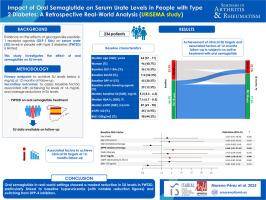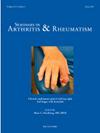Impact of oral semaglutide on serum urate levels in people with type 2 diabetes: A retrospective real-world analysis (URISEMA study)
IF 4.4
2区 医学
Q1 RHEUMATOLOGY
引用次数: 0
Abstract
Background
Evidence on the effects of glucagon-like peptide-1 receptor agonists (GLP-1 RAs) on serum urate (SU) levels in people with type 2 diabetes (PWT2D) is limited. This study investigates the effect of oral semaglutide on SU levels.
Methods
Retrospective, observational study including PWT2D who were prescribed oral semaglutide. The primary endpoint was achieving SU levels below 6 mg/dL at 12 months of follow-up (FU). Secondly, we assessed baseline factors associated with achieving SU levels of <6 mg/dL and average reductions in SU levels.
Results
The study included 236 patients (median age 64 years, BMI 33.8 kg/m², HbA1c 7.6 %, 40.7 % women, 52.3 % on SGLT2 inhibitors). Baseline SU was 5.2 mg/dL, 66.1 % had SU levels <6 mg/dL, and 23.7 % had hyperuricemia. Under oral semaglutide, 70.7 % and 76 % showed SU <6 mg/dL at 6 and 12 months, respectively. After multivariate adjustment, only SU ≥7 mg/dL (OR 4.54, 95 %CI 1.08–19.25) and switching from a DPP-4 inhibitor (OR 6.53, 95 %CI 1.57–27.32) were associated with achieving the SU target. SU decreased by 0.1 mg/dL after 6 months (p = 0.52) and by 0.2 mg/dL (p = 0.01) at 12 months FU. Greater reductions were observed in those with baseline SU >6 mg/dL (0.6 mg/dL and 0.8 mg/dl, respectively; all p < 0.001). Changes in SU levels were independent of improved metabolic control, weight loss, or baseline use of GLP-1 RAs or SGLT2 inhibitors.
Conclusion
Oral semaglutide in real-world settings showed a modest reduction in SU levels in PWT2D, particularly linked to baseline hyperuricemia (with notable reduction figures) and switching from DPP-4 inhibitors.

口服西马鲁肽对2型糖尿病患者血清尿酸水平的影响:一项回顾性现实世界分析(URISEMA研究)
关于胰高血糖素样肽-1受体激动剂(GLP-1 RAs)对2型糖尿病(PWT2D)患者血清尿酸(SU)水平影响的证据有限。本研究探讨口服西马鲁肽对SU水平的影响。方法回顾性观察研究,包括口服西马鲁肽的PWT2D患者。主要终点是在12个月的随访(FU)中SU水平低于6 mg/dL。其次,我们评估了与达到6 mg/dL的SU水平和SU水平的平均降低相关的基线因素。该研究包括236例患者(中位年龄64岁,BMI 33.8 kg/m²,HbA1c为7.6%,40.7%为女性,52.3%为SGLT2抑制剂)。基线血尿酸水平为5.2 mg/dL, 66.1%血尿酸水平为6mg /dL, 23.7%为高尿酸血症。口服西马鲁肽,70.7%和76%分别在6个月和12个月时出现6 mg/dL的SU和lt。多因素调整后,只有SU≥7 mg/dL (OR 4.54, 95% CI 1.08-19.25)和从DPP-4抑制剂切换(OR 6.53, 95% CI 1.57-27.32)与SU目标的实现相关。SU在6个月后下降了0.1 mg/dL (p = 0.52),在FU 12个月时下降了0.2 mg/dL (p = 0.01)。基线水平为6 mg/dL(分别为0.6 mg/dL和0.8 mg/dL;所有p <;0.001)。SU水平的变化与代谢控制的改善、体重减轻或GLP-1 RAs或SGLT2抑制剂的基线使用无关。结论:在现实环境中口服西马鲁肽可适度降低PWT2D患者的SU水平,特别是与基线高尿酸血症相关(具有显著的降低数字),并可从DPP-4抑制剂中切换。
本文章由计算机程序翻译,如有差异,请以英文原文为准。
求助全文
约1分钟内获得全文
求助全文
来源期刊
CiteScore
9.20
自引率
4.00%
发文量
176
审稿时长
46 days
期刊介绍:
Seminars in Arthritis and Rheumatism provides access to the highest-quality clinical, therapeutic and translational research about arthritis, rheumatology and musculoskeletal disorders that affect the joints and connective tissue. Each bimonthly issue includes articles giving you the latest diagnostic criteria, consensus statements, systematic reviews and meta-analyses as well as clinical and translational research studies. Read this journal for the latest groundbreaking research and to gain insights from scientists and clinicians on the management and treatment of musculoskeletal and autoimmune rheumatologic diseases. The journal is of interest to rheumatologists, orthopedic surgeons, internal medicine physicians, immunologists and specialists in bone and mineral metabolism.

 求助内容:
求助内容: 应助结果提醒方式:
应助结果提醒方式:


